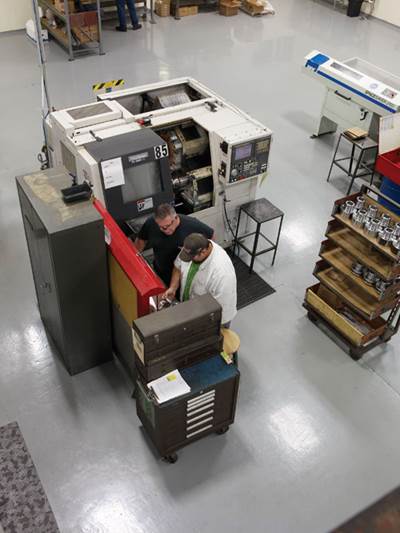Is an ESOP Your Answer?
For the growing number of shop owners mulling exit strategies, Employee Stock Ownership Plans (ESOPs) can benefit all involved parties.
Share








Autodesk, Inc.
Featured Content
View More
Hwacheon Machinery America, Inc.
Featured Content
View MoreWhen the time seems right to exit the business, a shop owner has options. These include selling to a competitor, offering a buyout to management or transferring the company to a family member. However, employee ownership via an ESOP can be an attractive alternative when other options are unappealing or simply not feasible.
An ESOP, or Employee Stock Ownership Plan, offers a way to put ownership into the hands of a company’s workforce. ESOP legislation, approved in the 1970s as a qualified retirement plan, became a tool that small businesses could use to transfer equity ownership to the company’s employees. Its popularity as a business succession tool has ebbed and flowed over the years. However, combining the number of baby boomers eyeing retirement with what seems to be an improving economy, it’s a safe bet that the rate at which new ESOPs are created will soon rise.
In essence, an ESOP is a trust that can go into debt on behalf of a company’s employees to buy out the existing owner(s). Once the ESOP is established, the company makes contributions that gradually pay off the transaction debt. Under the right circumstances, an ESOP can benefit all parties involved.
Rable Machine, the shop I profiled in this article, became 100-percent employee-owned in 1998. Prior to the shop’s ESOP transition, its owner received guidance from the Ohio Employee Ownership Center. The OEOC, located on the campus of Kent State University, is a non-profit organization established in 1987 to provide information and preliminary technical assistance to Ohio business owners interested in exploring employee ownership options.
During a recent phone chat, Jay Simecek, OEOC program coordinator, pointed out a number of advantages that an ESOP succession plan offers. For instance, an ESOP provides flexibility by enabling an owner to sell only a portion of the company to the ESOP so he or she can exit the business in stages. This permits an owner to make liquid some of the wealth tied up in the business while retaining an ownership position.
There are tax advantages to an ESOP, too, because the owner can defer all capital gains tax on the portion that’s sold to the ESOP. The company also experiences tax savings because both the principle and interest on the ESOP loan payment can be deducted. Plus, companies that are S corporations don’t pay federal income tax on the ESOP portion.
Studies show that business performance typically increases after an ESOP is established, as long as a company-wide communicative and participative culture is embraced. In addition, the sustainability that an ESOP offers keeps businesses (and jobs) anchored in their local communities while contributing to area wealth creation.
Mr. Simecek notes that even when 100 percent of the company is sold to the ESOP, ownership isn’t literally in the hands of the employees; it’s in the hands of the ESOP trust. That means a company’s organization structure and chain of command don’t have to change. However, employees will expect to participate more because they have a direct financial stake in the business. They should be able to add input to the decisions made at the business, and communication between management and employees regarding company performance should be frequent and detailed.
Mr. Simecek often talks with business owners about ESOP prerequisites and qualification. First, he says, the company should be profitable so it can repay an ESOP loan. When working with a business, he’ll look over the company’s balance sheet and income statement, determine the company’s level of debt and decide whether it is large enough to support ESOP startup and ongoing costs. Startup costs can be high depending on how the deal is structured. In addition, ongoing costs can be high, especially if an external trust service is used as the ESOP’s trustee. Although external trust services can be pricey, there’s less likely to be a conflict of interest with a trustee that’s outside the company versus a company executive assigned to be the ESOP’s trustee. A feasibility study that includes a business valuation should be performed to determine the business’ market value. In some cases, small business owners don’t have an accurate idea as to what their business is worth or what the market is willing to bear.
In the end, Mr. Simecek says company management must be open to share ownership. In some instances, this willingness simply isn’t there. He also says its best that businesses already have an established culture of participation and communication among all employees so that the transformation to an employee-ownership model isn’t so drastic once an ESOP is completed.
Read Next
The Employee-Owned Advantage
This Ohio shop is 100-percent employee-owned. Thus, both management and shopfloor employees recognize the importance of optimizing efficiency wherever possible. Thanks to a strong willingness to invest in and embrace new technologies, sales-per-employee has increased by more than 50 percent in the last five years.
Read MoreBuilding Out a Foundation for Student Machinists
Autodesk and Haas have teamed up to produce an introductory course for students that covers the basics of CAD, CAM and CNC while providing them with a portfolio part.
Read More5 Rules of Thumb for Buying CNC Machine Tools
Use these tips to carefully plan your machine tool purchases and to avoid regretting your decision later.
Read More














.png;maxWidth=150)



















.png;maxWidth=300;quality=90)






